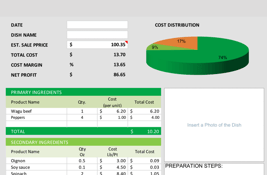Franchising a restaurant can be lucrative for restaurant owners seeking expansion opportunities. According to recent statistics, the restaurant industry is projected to reach a value of $1.2 trillion by 2030, indicating immense potential for growth and profitability.
However, navigating the franchising process can be complex and requires careful planning and execution. In this comprehensive guide, we will explore the essential steps and considerations for successfully franchising a restaurant, covering aspects such as business planning, legal compliance, staff training, and effective marketing strategies.
What is a restaurant franchise?
A restaurant franchise refers to a business model where a restaurant owner (the franchisor) grants the rights to another party (the franchisee) to operate a replica of their established restaurant concept.
Popular restaurant franchising examples include McDonald's, Subway, and Pizza Hut. Franchising offers entrepreneurs a pathway to business ownership with reduced risk and greater chances of establishing a successful business.
Should you franchise your restaurant?
Deciding whether to franchise your restaurant requires careful evaluation of various factors:
- Firstly, assess the financial performance of your own restaurant. Strong and consistent profitability is crucial for successful franchising, so we advise a SWOT analysis first.
- Next, consider your brand identity. Is it unique, scalable, and easily replicated? A strong brand with a loyal customer base enhances franchise prospects.
- Additionally, analyze market demand for your concept. Is there a demand for your restaurant in other locations?
- Conduct market research to gauge potential customer interest.
- Operational requirements are also essential. Ensure your restaurant has well-documented and replicable processes to maintain consistency across franchise locations.
- Lastly, understand the legal and regulatory obligations associated with franchising, such as drafting franchise agreements and protecting the intellectual property of your own business.
Evaluating these aspects will help determine if franchising is a viable growth strategy for your restaurant, providing increased brand exposure, revenue streams, and expansion opportunities.
-2-1.webp?width=800&height=450&name=image1%20(5)-2-1.webp)
How to franchise a restaurant in 6 steps
Embarking on franchising your restaurant requires a systematic approach and careful planning. Here are six key steps to guide you through the process:
1. Develop a franchise business plan
To begin, create a comprehensive franchise business plan that outlines your franchise system, structure, and expansion goals. Define brand standards, financial projections, and investment requirements. This restaurant business plan will serve as a roadmap for your franchise development, ensuring clarity and consistency in your approach.
2. Create franchise support systems
Establishing robust franchise support systems is crucial for maintaining consistency across locations. Standardize operations by documenting processes in a restaurant operations manual and developing franchise training programs. Implement quality control measures to ensure the brand experience remains consistent across all franchise outlets, thereby preserving customer loyalty and restaurant brand reputation.
3. Understand legal and regulatory compliance
Navigating the legal and regulatory aspects of franchising is paramount. Familiarize yourself with franchise laws and regulations in your target markets. Consult with legal professionals to draft franchise agreements and disclosure documents and protect your intellectual property rights. Complying with legal requirements helps safeguard your parent company and ensures a solid foundation for successful franchise operations.
4. Find the franchisees
Finding the right franchisees is vital for the growth and success of your franchise network. Seek individuals who align with your brand values, possess relevant experience, and demonstrate the necessary financial capabilities. Implement a thorough screening and selection process to identify potential franchisees who will uphold your brand standards and contribute to the franchise's overall success.
5. Train the staff
Comprehensive training programs are essential to equip franchisees and their staff with the necessary skills and knowledge to operate your restaurant concept effectively. Provide a complete training manual, conduct hands-on training sessions, and offer ongoing support to ensure franchisees and their teams deliver customers a consistent and exceptional dining experience.
6. Market and advertise
Effectively marketing and advertising your franchise is crucial for attracting customers and driving business growth. Develop a strategic digital marketing plan combining national and local marketing efforts. Utilize digital marketing channels, social media platforms, and traditional advertising methods to create brand awareness, generate buzz, and promote the unique value proposition of your franchise.
By following these six essential steps, you can confidently navigate the franchising process and set your restaurant on a path to expansion and success. Remember, thorough planning, meticulous execution, and ongoing support are key to building a successful restaurant franchise network.
How to use technology to streamline restaurant operations
-2-1.webp?width=800&height=504&name=image6%20(5)-2-1.webp)
Technology plays a vital role in streamlining restaurant operations and maximizing efficiency. One such technology solution is Eat App, which offers a range of tools to enhance restaurant management and franchise operation, which are essential when running a successful restaurant.
To begin with, Eat App's data analysis capabilities can help identify franchise potential. The platform analyzes trends and customer preferences and provides valuable insights into peak dining times, popular menu items, and customer feedback. This information assists restaurant owners in evaluating the viability of their concept and understanding the potential demand for franchising in specific locations.
For franchisees, Eat App's platform offers a streamlined approach to operations. Franchisees can leverage the platform to optimize their day-to-day activities, such as reservation and seating management, staff scheduling, and customer communication. By utilizing these features, franchisees can ensure smooth operations, maintain consistency across multiple locations, and uphold the quality and brand identity of the restaurant concept.
Additionally, Eat App enables franchise owners to track the performance of each location effectively. The platform provides access to key metrics such as reservation conversion rates, average guest spending, and customer satisfaction scores. By monitoring these performance indicators, franchise owners can identify successful practices, pinpoint areas for improvement, and make data-driven decisions to maintain consistent quality standards throughout the franchise network.
Using technology, specifically Eat App, in restaurant operations streamlines processes, enhances efficiency, and improves overall customer experience. By leveraging the insights and functionalities provided by this platform, restaurant owners and franchisees can make informed decisions, optimize operations, and ultimately drive the success of their restaurant franchise.
In a rapidly evolving industry, staying ahead of the curve with technological solutions is essential for sustained growth and competitiveness. Incorporating tools like Eat App can revolutionize restaurant operations and set the stage for a successful and thriving franchise network.
-2-1.webp?width=800&height=362&name=image4%20(6)-2-1.webp)
Conclusion
Franchising a restaurant presents a tremendous opportunity for growth and profitability in the dynamic food service industry. By carefully evaluating financial performance, brand identity, market demand, and operational requirements, restaurant owners can decide whether franchising is the right path for their business.
Following a strategic roadmap that includes developing a franchise business plan, establishing robust support systems, ensuring legal compliance, finding the right franchisees, training staff, and implementing effective marketing strategies and software tools sets the stage for success.
Embracing technology like Eat App further streamlines operations enhances customer experiences, and allows for data-driven decision-making.
With thorough planning, execution, and ongoing support, franchising can unlock new horizons for restaurant owners, fostering growth, brand expansion, and profitability.
Sign up for Eat App and start building your franchising strategy today!
FAQs
How much money do I need to start a franchise?
The amount of money required to start a franchise varies greatly depending on the brand, industry, and location. It can range from tens of thousands to millions of dollars. Conduct thorough research and consult with the franchisor to determine the specific financial requirements.
Is it hard to start a restaurant franchise?
Starting a restaurant franchise can be challenging, as it involves careful planning, adherence to franchise guidelines, and navigating legal and operational complexities. However, with proper preparation, support from the franchisor, and a solid business plan, it is achievable with determination and hard work.
Is it profitable to own a franchise?
The profitability of owning a franchise depends on various factors, including the brand, market demand, location, and the owner's ability to manage operations effectively. Successful franchises have the potential to generate significant profits, but it's important to conduct thorough financial analysis and consider long-term sustainability.
Is it more profitable to buy a restaurant franchise or to franchise your current restaurant?
Comparing the profitability of buying a restaurant franchise versus franchising your existing restaurant depends on individual circumstances. Buying a franchise offers an established brand and support system while franchising your current restaurant leverages your existing customer base and operational expertise. Assessing financial projections and growth potential is essential in making this decision.














.webp?width=200&name=v2-15mknc-qpw1b%20(1).webp)
.webp?width=200&name=v2-15kqni-p0exl%20(1).webp)
-1.png?width=1812&height=1072&name=TripAdvisor%20%26%20More%20Bookings%20(1)-1.png)
-2.png?width=1812&height=1072&name=Google%20Bookings%20(1)-2.png)


-1.png?width=200&name=TripAdvisor%20%26%20More%20Bookings%20(1)-1.png)
-2.png?width=200&name=Google%20Bookings%20(1)-2.png)
-1.png?width=200&name=Instagram%20Bookings%20(1)-1.png)
-1-png.webp?width=200&name=Facebook%20Integration%20Rectangle%20(1)-1-png.webp)







.webp?width=200&name=download%20(1).webp)
%20(1)-2.webp?width=200&name=Eat%20(34)%20(1)-2.webp)
%20(1)-2.webp?width=200&name=Eat%20(18)%20(1)-2.webp)




-2-1.webp?width=670&height=440&name=image5%20(6)-2-1.webp)



%20(1)-1.webp?width=314&height=175&name=Eat%20(62)%20(1)-1.webp)


.webp?width=144&height=72&name=Eat%20App%20Logo%20(3).webp)